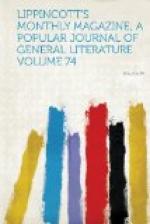while the masked inmates pelt and get pelted in turn
with comfits made of painted clay. The Corso
is also the scene of numerous religious processions,
some of which are quaint and picturesque. There
are a number of ancient confraternities established
amongst the trades-people of Nice, who wear costumes
of, red, white, black and blue serge, according to
the guild they belong to. This sack-like garment
covers them from head to foot, face and all, there
being only two eyeholes slit in the mask to permit
the wearer to see out. These brotherhoods attend
the sick, bury the dead and take care of the widows
and orphans, and in Holy Week make the narrow streets
of the old city delightful to the artistic eye by
the bright mass of their vivid-colored raiment, the
flickering of their tapers, and the gigantic crucifixes
of gold and silver they carry in procession from church
to church. Every morning there is a market held
on the Corso of fruits, vegetables and flowers.
Such magnificent baskets of camellias, japonicas and
roses, such nosegays of violets and orange-blossoms,
can be seen, I fancy, nowhere but at Nice. Here
also the peasant-women sometimes bring immense pots
of Peruvian aloes for sale, whose snowy blossoms are
scented like those of the magnolia, and rise in gigantic
pyramids of magnificent cup-shaped flowers. They
are plants to salute respectfully as you pass by them,
such is their size and dignity. In Holy Week women
are to be seen all over the old town selling plaited
palm branches of a pale straw-color, some of which
are bedecked with little bows of ribbon or stars of
tinsel, used in the ceremonies of Palm Sunday.
The peasant-girls who come to market at Nice are rather
handsome, but as dark as Nubians, with almond-shaped
eyes and long, coarse black hair, which they wear
plaited into tails bound round the head with broad
velvet ribbons, like a coronet. On the top of
this headgear they sport a wide-brimmed straw hat
of peculiar shape, ornamented with little black crosses
made of narrow velvet. In Princess Marie Lichtenstein’s
Holland House there is a portrait of Lady Augusta
Holland wearing one of these Nice hats.
But it is time for us to cross the bridges and pay
our respects to Nice the “new.” When
I first visited Nice in 1856 at least two-thirds of
this part of the city were not in existence.
There were no splendid railway-stations then; only
one or two, instead of twenty, monster hotels; the
Promenade des Anglais only extended about a mile along
the shore, instead of four; and there were but one
quay and two bridges. Now superb quays line the
river on either side, and there are six bridges, and
Heaven only knows how many churches for the accommodation
of all the denominations imaginable and unimaginable,
from Pere Lavigne’s very beautiful and very
orthodox church, in which Monsignor Capel has preached
in Lent, down to Leon Pilate’s, where collections
are made for the evangelical missions presided over
by Mrs. Gould and W.C. Van Metre. There




